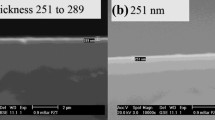Abstract
Hydrogenated microcrystalline silicon (μc-Si:H) thin films were deposited by inductively coupled plasma assistant magnetron sputtering (ICP-MS) in an Ar-H2 gas mixture. The role of ion bombardment in the growth of μc-Si:H films was studied with increasing negative bias voltages on the substrate holder from 0 to −100 V. Raman scattering, X-ray diffraction (XRD), Fourier transform infrared (FTIR) spectroscopy and transmission electron microscopy (TEM) were performed to investigate the microstructure changes of deposited Si films. Raman scattering showed that the high energy ion bombardment resulted in crystalline degradation of Si films. The XRD results showed the decrease and even elimination of preferential growth orientation of crystalline Si films with ion bombardment energy increase. The SiH bonding configuration changes and the increase of bonded hydrogen concentration were determined with the analysis of FTIR spectra. Furthermore, the dramatic evolution of cross-sectional morphology of Si thin films was detected by TEM observation.
Similar content being viewed by others
References
Kim S W, Choi D L. Nanocrystalline silicon fabrication by conventional plasma enhanced chemical vapor deposition for bottom gate thin film transistor. Mater Lett, 2010, 64:1975–1977
Hou G F, Xue J M, Yuan Y J. A fast method to diagnose phase transition from amorphous to microcrystalline silicon. Sci China Ser G-Phys Mech Astron, 2007, 50:731–736
Juang M H, Hu P S, Jang S L. Formation of polycrystalline-Si thin-film transistors with tunneling field-effect-transistor structure. Thin Solids Films, 2009, 518:3978–3981
Cheng Q J, Xu S U, Ostrikov K K. Rapid, low-temperature synthesis of nc-Si in high-density, non-equilibrium plasmas: Enabling nanocrystallinity at very low hydrogen dilution. J Mater Chem, 2009, 19:5134–5140
Yuan Y J, Zhang K L, Wei Z, et al. Influence of p-layer on the performance of n-i-p mu c-Si:H thin film solar cells. Sci China-Phys Mech Astron, 2010, 53:2042–2046
Wang C L, Fan D W, Wang C B, et al. Poly-Si films with low aluminum dopant containing by aluminum-induced crystallization. Sci China-Phys Mech Astron, 2010, 53:111–115
Yu W, Meng L H, Yuan J, et al. Influence of substrate temperature on growth of a-Si:H films by reactive facing target sputtering deposition. Sci China-Phys Mech Astron, 2010, 53:807–811
Li Z Y, Li Y, Chen C, et al. Influence of silicon cluster on epitaxial growth of silicon carbide. Sci China-Phys Mech Astron, 2011, 54:1579–1582
Wen C, Fu C, Tang J L, et al. The influence of environment temperatures on single crystalline and polycrystalline silicon solar cell performance. Sci China-Phys Mech Astron, 2012, 55:235–241
Su Y J, Xu J, Zhu M. Hydrogenated poly-crystalline silicon thin films deposited by inductively coupled plasma assistant pulse dc twin magnetron sputtering (in Chinese). Acta Phys Sin, 2012, 61: 021804
Messier R. The nano-world of thin films. J Nanophoton, 2008, 2: 21995
Bustarret E, Hachicha M A, Brunel M. Experiment determination of the nanocrystalline volume fraction in silicon thin films from Raman spectroscopy. Appl Phys Lett, 1988, 52:1675–1677
Cheng Q J, Xu S Y, Huang S Y. Effective control of nanostructured phases in rapid, room temperature synthesis of nanocrystalline Si in high-density plasmas. Cryst Growth Design, 2009, 9:2863–2867
Brodsky M H, Cardona M, Cuomo J J. Infrared and Raman spectra of the silicon-hydrogen bonds in amorphous silicon prepared by glow discharge and sputtering. Phys Rev B, 1977, 16:3556–3571
Hu Y H, Chen G H, Wu Y Y. Infrared-transmission spectra and hydrogen content of hydrogenated amorphous silicon. Sci China Ser G-Phys Mech Astron, 2004, 47:381–392
Sidhu L S, Kosteski T, Zukotynski S. Infrared vibration spectra of hydrogenated, deuterated, and tritiated amorphous silicon. J Appl Phys, 1999, 85:2574–2578
Smets A H M, Kessels W M M, van de Sanden M C M. Vacancies and voids in hydrogenated amorphous silicon. Appl Phys Lett, 2003, 82:1547–1549
Gu J H, Zhu M F, Wang L J. The compact microcrystalline Si thin film with structure uniformity in the growth direction by hydrogen dilution profile. J Appl Phys, 2005, 98:93505–93510
Higashi G S, Chabal Y J, Trucks G W. Ideal hydrogen termination of the Si (111) surface. Appl Phys Lett, 1990, 56:656–658
Stryahilev D, Diehl F, Schroder B. The splitting of absorption bands in IR spectra of anisotropic SiH monolayers covering the internal surfaces in μc-Si:H. J Non-Cryst Solids, 2000, 266–269:166–170
Yu W, Meng L H, Yuan J. Influence of substrate temperature on growth of a-Si:H films by reactive facing target sputtering deposition. Sci China-Phys Mech Astron, 2010, 53:807–811
Maley N. Critical investigation of the infrared-transmission-data analysis of hydrogenated amorphous silicon alloys. Phys Rev B, 1992, 46:2078–2085
Chen Y S, Xu Y H, Gu J H. Study of amorphous incubation layers during the growth of microcrystalline silicon films under different deposition conditions. Chin Phys B, 2010, 19:87206
Mullerava J, Sutta P, van Elzakker G. Microstructure of hydrogenated silicon thin films prepared from silane diluted with hydrogen. Appl Surf Sci, 2008, 254:3690–3695
Author information
Authors and Affiliations
Corresponding author
Rights and permissions
About this article
Cite this article
He, Y., Su, Y., Zhu, M. et al. Effects of ion bombardment on microcrystalline silicon growth by inductively coupled plasma assistant magnetron sputtering. Sci. China Phys. Mech. Astron. 55, 2070–2075 (2012). https://doi.org/10.1007/s11433-012-4858-7
Received:
Accepted:
Published:
Issue Date:
DOI: https://doi.org/10.1007/s11433-012-4858-7




